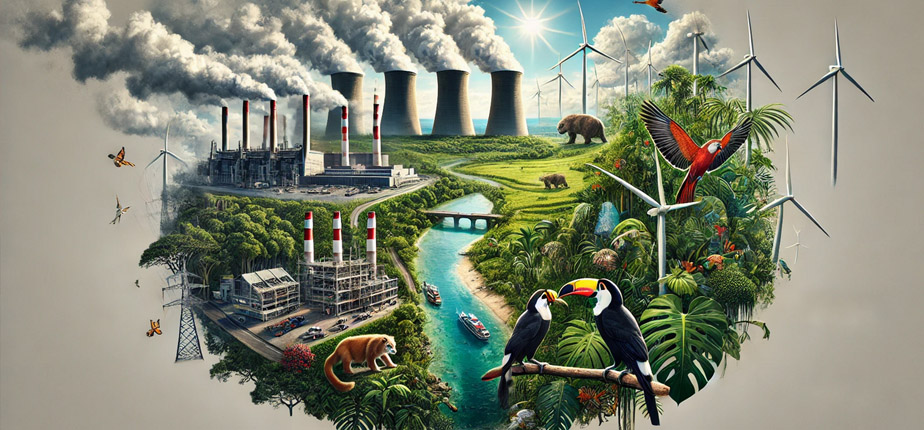
2024 was a year of records for the environment—the hottest year on record, the fastest intensification of a hurricane/typhoon, and the first year that temperatures reached 1.5°C above pre-industrial levels. Still, the news was not all bad.
2024 was also the year the UK closed its last coal-fired power plant, the U.S. generated record power from wind, and the Amazon Rainforest had record-low deforestation.
As dire climate predictions abound, governments and communities are working to reverse the trend of climate change, protect biodiversity, and invest in climate resilience for the most vulnerable populations. The Muslim News will explore some of this year’s more positive environmental trends.
On September 30, the Ratcliffe-on-Soar coal-fired power plant in Nottinghamshire closed, ending the UK’s 142-year era of coal production.
Throughout the 20th century, coal was widely used in UK power generation, peaking in 1913 but remaining robust until the 1990s and then sharply declining over the last 30 years. Coal imports peaked in 2006 and 2013 but have since declined as well. This year, wind power is set to outpace combined gas and coal electricity generation in the UK.
While global demand for coal is high, at 8.77 billion metric tonnes in 2024, a 1% increase from the previous year, it is a much slower increase than in recent years, which was around 7%.
In the last decade, there has been a concerted effort to curb its production and use. Forty years ago, coal generated 50% of U.S. electricity, and last year it was down to 16%.
Developing countries are also trying to pivot away from highly polluting fossil fuels. In India, renewable energy makes up 70% of new power generation.
The International Energy Agency forecasts, “Renewable energy consumption in the power, heat, and transport sectors increases nearly 60% over 2024-2030.” Scaling production and increasing the capacity of renewable energy technologies through scientific advancements help decrease costs and make renewables more accessible.
2024 also saw advancement in grid integration for renewables, which increases utilities’ resilience.
The Amazon Rainforest saw a sharp decline in deforestation, the lowest in 9 years, thanks to President Lula’s reversal of his predecessor’s pro-agribusiness policies and focus on conservation in the biodiverse region.
The statistics do not account for Amazon rainforest degradation, which increased during the same period. Degradation is caused by wildfires and logging, whereas deforestation refers to clearcutting.
Drought plagued the region, and President Lula has faced criticism from environmentalists for some of his Amazon proposals, including oil drilling and highway construction.
Still, the Cerrado, or Amazon savannah, saw the first decline in deforestation in 5 years. In 2025, Brazil is set to host COP30 in Belem, which will likely spur a greater push for rainforest conservation efforts, as the Amazon is host to 16,000 known tree species and is considered a carbon sink, slowing global warming.
Conservation efforts abound but compete with illicit and legitimate enterprises, including agriculture, ranching, timber, and gold.
2024 saw some wins for biodiversity, a key indicator of environmental health, contributing to pollination, water purification, climate regulation, and more.
In southern Spain and Portugal, the Iberian lynx is rebounding from extinction due to conservation efforts. Its status was downgraded from “endangered” to “vulnerable” in June due to successful habitat restoration, captive breeding, reintroduction, and bolstering the rabbit population, the lynx’s primary food source. Scientists hope to keep the momentum going so the population can reach sustainable levels.
Another encouraging biodiversity story occurred in Australia, which is set to open its newest national park, Cuttaburra, in 2025.
According to the park’s website, Cuttaburra National Park “is home to at least 12 threatened species, including the stripe-faced dunnart, brolga, eastern fat-tailed gecko, black-breasted buzzard, and little eagle.” The park includes shrubland plains, swamps, river floodplains, and dunes and is home to 158 native fauna species that will now be protected.
Stories about the environment are often dire, predicting a planet uninhabitable in the coming years without momentous effort and consistent financing. The projections hold merit and have spurred some successful action from governments, environmental groups, businesses, and individuals.
There is strong momentum to reverse climate change, but the pace of action and legally enforceable policies will determine how dire future stories will be.
Will new energy-intensive AI data centres be required to run primarily on renewable energy? Will regions recovering from record-breaking natural disasters invest in green and resilient infrastructure?
2025 will test the commitments of governments that have pledged to create a more ecologically sustainable future and protect vulnerable populations and habitats.
Sarah Sakeena Marshall